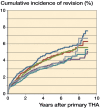The effect of bearing type on the outcome of total hip arthroplasty
- PMID: 29160130
- PMCID: PMC5901513
- DOI: 10.1080/17453674.2017.1405669
The effect of bearing type on the outcome of total hip arthroplasty
Abstract
Background and purpose - Alternative bearing surfaces such as ceramics and highly crosslinked polyethylene (HXLPE) were developed in order to further improve implant performance of total hip arthroplasties (THAs). Whether these alternative bearing surfaces result in increased longevity is subject to debate. Patients and methods - Using the Dutch Arthroplasty Register (LROI), we identified all patients with a primary, non-metal-on-metal THA implanted in the Netherlands in the period 2007-2016 (n = 209,912). Cumulative incidence of revision was calculated to determine differences in survivorship of THAs according to bearing type: metal-on-polyethylene (MoPE), metal-on-HXLPE (MoHXLPE), ceramic-on-polyethylene (CoPE), ceramic-on-HXLPE (CoHXLPE), ceramic-on-ceramic (CoC), and oxidized-zirconium-on-(HXL)polyethylene (Ox(HXL)PE). Multivariable Cox proportional hazard regression ratios (HRs) were used for comparisons. Results - After adjustment for confounders, CoHXLPE, CoC, and Ox(HXL)PE resulted in a statistically significantly lower risk of revision compared with MoPE after 9 years follow-up (HR =0.8-0.9 respectively, compared with HR =1.0). For small (22-28 mm) femoral head THAs, lower revision rates were found for CoPE and CoHXLPE (HR =0.9). In the 36 mm femoral head subgroup, CoC-bearing THAs had a lower HR compared with MoHXLPE (HR =0.7 versus 1.0). Crude revision rates in young patients (< 60 years) for CoHXLPE, CoC, and Ox(HXL)PE (HR =0.7) were lower than MoPE (HR =1.0). However, after adjustment for case mix and confounders these differences were not statistically significant. Interpretation - We found a mid-term lower risk of revision for CoHXLPE, CoC, and Ox(HXL)PE bearings compared with traditional MoPE-bearing surfaces.
Figures
References
-
- Australian Orthopaedic Association National Joint Replacement Registry (AOANJRR). Annual report 2016.
-
- Dutch Arthroplasty Register (LROI). Annual report. LROI report, 2015.
MeSH terms
Substances
LinkOut - more resources
Full Text Sources
Other Literature Sources
Medical


